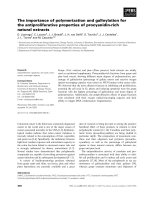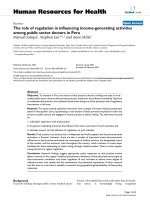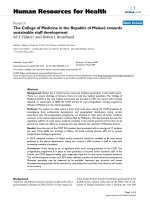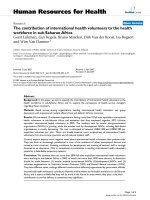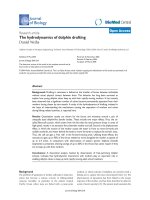Báo cáo sinh học : " The importance of mathematics in biology is a matter of perennial debate" pot
Bạn đang xem bản rút gọn của tài liệu. Xem và tải ngay bản đầy đủ của tài liệu tại đây (53.27 KB, 2 trang )
Editorial
BBiioollooggiissttss wwhhoo ccoouunntt**
Miranda Robertson
The importance of mathematics in
biology is a matter of perennial
debate. The squabbles of early 20th
century geneticists on the value of
mathematics to the study of evolution
have recently been revisited in Journal
of Biology [1], and the 21st century has
seen an explosion of information
from various -omics and imaging
techniques that has provided fresh
impetus to the arguments urging the
need for mathematical competence in
the life sciences [2]. While there can
be no question about the contribution
of mathematics to many fields in
biology, there is a curious tendency on
the part of numerate biologists (often
immigrants from the physical
sciences) to insist that it is an essential
part of the equipment of a biologist
and none should be without it. This
seems, on the evidence, extreme.
A more temperate view is taken, if
implicitly, by Ferrell [3] in his recent
Q&A for Journal of Biology on systems
biology. (Explicitly, at least in the
context of systems biology, he is
uncompromising on the math
prerequisite.).
Leaving aside the issue of exactly how
you define systems biology, one of the
objectives of those who would say
they are practitioners is to understand
the emergent properties of complex
systems. Examples of such properties
in biological systems are the
biochemical switches and oscillators
that underlie the cell cycle, and the
robustness of biological mechanisms -
for example, the morphogenetic
gradients that direct early embryonic
development - in conditions that are
subject to stochastic fluctuation.
Ferrell argues that mathematics is
required to understand the behavior
of an entire system; but acknowledges
the value of understanding at a more
parochial level the mechanism of parts
of it. He gives as a classic example of a
switch in biology the gene-regulatory
switch [4] that operates the decision
between lysis and lysogeny in
bacteriophage lambda.
Lambda, which infects E. coli, inserts
its genome into that of the bacterium
and can then either reproduce itself
and lyse the bacterial cell (lysis), or
remain in a latent state in which it is
replicated with the bacterial genes
(lysogeny) until an environmental
change flips the switch to the lytic
program. The basis for the switch is
the competitive binding to DNA of
two proteins, one of which (repressor)
represses the lytic programme and
activates its own synthesis,
maintaining the lysogenic state, while
the other represses the synthesis of the
repressor and activates the lytic
programme and its own synthesis,
maintaining the lytic state. (The
switch is operated by an
environmentally controlled cellular
protein that decreases the affinity of
repressor for DNA.) This mechanism
was worked out, as far as I know,
without recourse to mathematics.
A gene regulatory switch of a
somewhat analogous kind is an
essential component of the
developmental mechanism explored
in the review by Lewis, Hanisch and
Holder in this issue of Journal of
Biology on the part played by the
receptor protein Notch in the
formation of somites in the
developing embryo [5]. This process
depends on an oscillator known as the
segmentation clock, which dictates the
formation of regular blocks of tissue
(somites) from the embryonic
mesoderm. Known components of the
clock are the Notch receptor protein
and its ligand, Delta, which is also a
cell-surface protein; and the products
of the Hes/her genes, which are gene
regulatory proteins that act as
transcriptional inhibitors. Notch
signaling activates the Hes/her genes,
whose products feed back to inhibit
both their own transcription and that
of the Delta gene. Broadly - at least for
zebrafish - the Hes/her genes are
thought to provide a cell-intrinsic
oscillator through negative
autoregulation, with Notch signaling
synchronizing the autonomous
oscillators in adjacent cells of the
mesoderm
It is not surprising that an
understanding of the properties of this
oscillating system requires
Journal of Biology
2009,
88::
34
mathematics; indeed Lewis argues
cogently that the behavior of the
Hes/her oscillator alone is beyond the
reach of simple intuition.
Moreover the biological facts, which
are almost always beyond the reach
of most people's intuition, seem to
indicate that an even more complex
system operates in mammals (or at
least mice, from which it is probably
safe to generalize), in which
fibroblast growth factor (FGF) and
Wnt signaling are also implicated,
and in which the Hes/her cell-
intrinsic oscillator may not be the
only one.
So ostensibly significant a difference
between vertebrates in so fundamental
a process seems surprising, and may
dwindle (either in extent or in
significance) with the accumulation of
more facts.
In any event, if mathematics must be
applied to make sense of the facts, at
least in so complex a system as a
developing embryo, then facts - and
indeed understanding - at many levels
must be fed into the mathematics. Nor
should the value of facts and
understanding on their own be
dismissed. The case for Darwin's
theory of evolution by natural
selection would have been
strengthened had he been
mathematician enough to recognize
Mendelian ratios, but this scarcely
diminishes his monumental
achievement.
There seems no need for the snobbery
(it is said) of the highly quantitative
founding biologists at the Cold Spring
Harbor Laboratories, in whose early
history ex-physicists played a crucial
part, and who are alleged to have
referred to their nearby colleagues at
Woods Hole as biologists 'who don't
count'.
Miranda Robertson, Editor
*The version of this editorial that appeared
from May 22-27 contained some egregious
errors that have been corrected in this one.
RReeffeerreenncceess
1. Crow JF:
MMaayyrr,, mmaatthheemmaattiiccss aanndd tthhee
ssttuuddyy ooff eevvoolluuttiioonn
J Biol
2009,
88::
13.
2. Bialek W, Botstein D:
IInnttrroodduuccttoorryy
sscciieennccee aanndd mmaatthheemmaattiiccss eedduuccaattiioonn ffoorr
2211sstt cceennttuurryy bbiioollooggiissttss
Science
2004,
330033::
788-90.
3. Ferrell JE:
QQ&&AA SSyysstteemmss bbiioollooggyy
J Biol
2009,
88::
2.
4. Ptashne M:
A Genetic Switch: Phage
Lambda Revisited
New York, Cold
Spring Harbor Press; 2004.
5. Lewis J, Hanisch A, Holder M:
NNoottcchh ssiigg
nnaalliinngg,, tthhee sseeggmmeennttaattiioonn cclloocckk,, aanndd tthhee
ppaatttteerrnniinngg ooff vveerrtteebbrraattee ssoommiitteess
J Biol
2009,
88::
44.
Published: 27 May 2009
Journal of Biology
2009,
88::
34
(doi:10.1186/jbiol146)
The electronic version of this article is the
complete one and can be found online at
/>© 2009 BioMed Central Ltd
34.2
Journal of Biology
2009, Volume 8, Article 34 Robertson />Journal of Biology
2009,
88::
34
